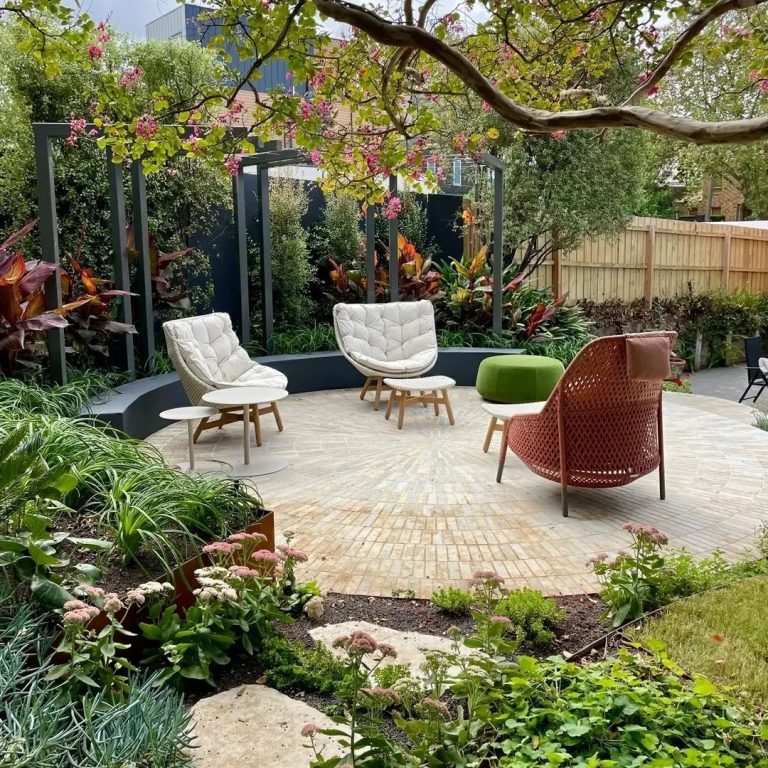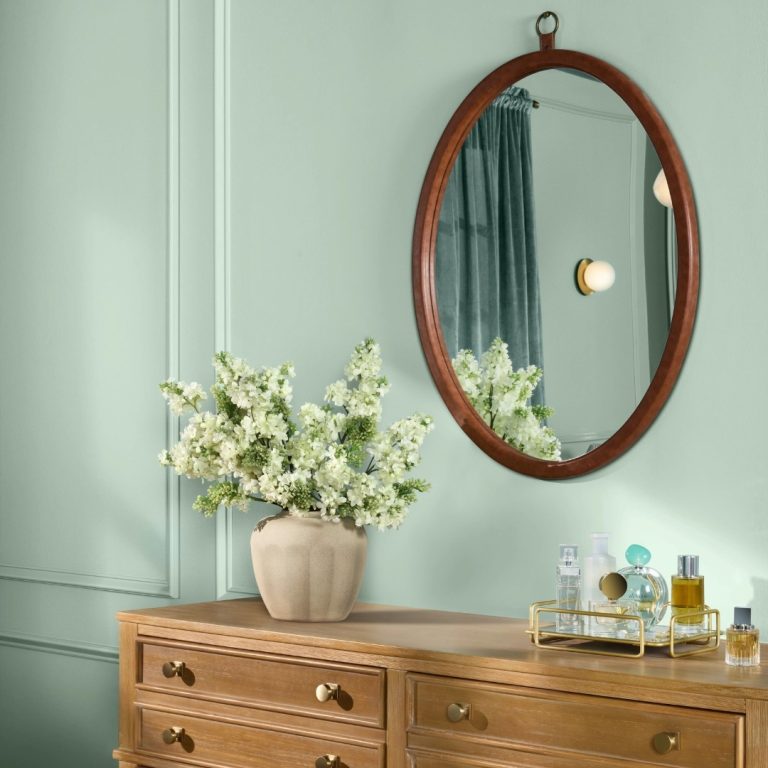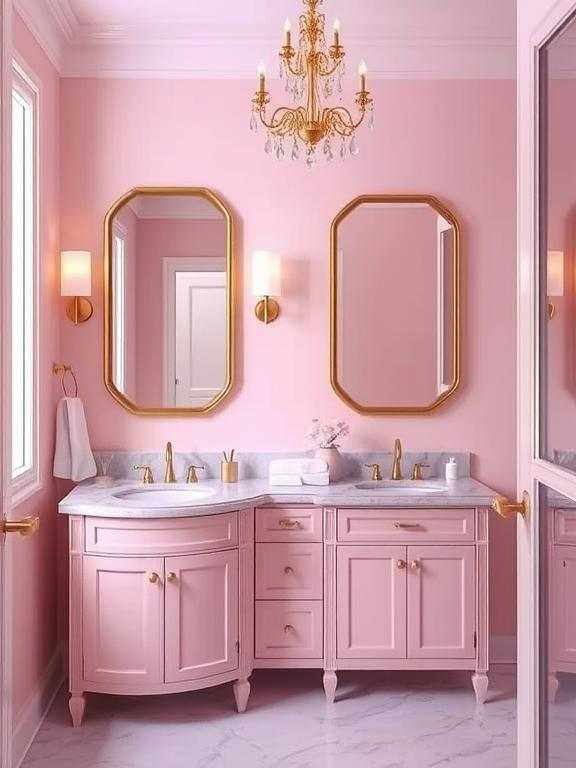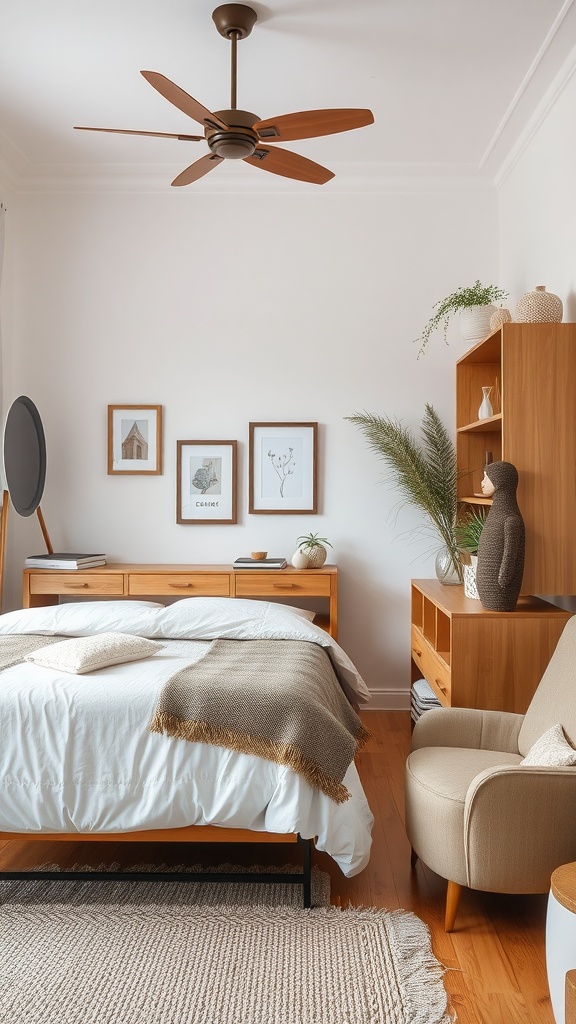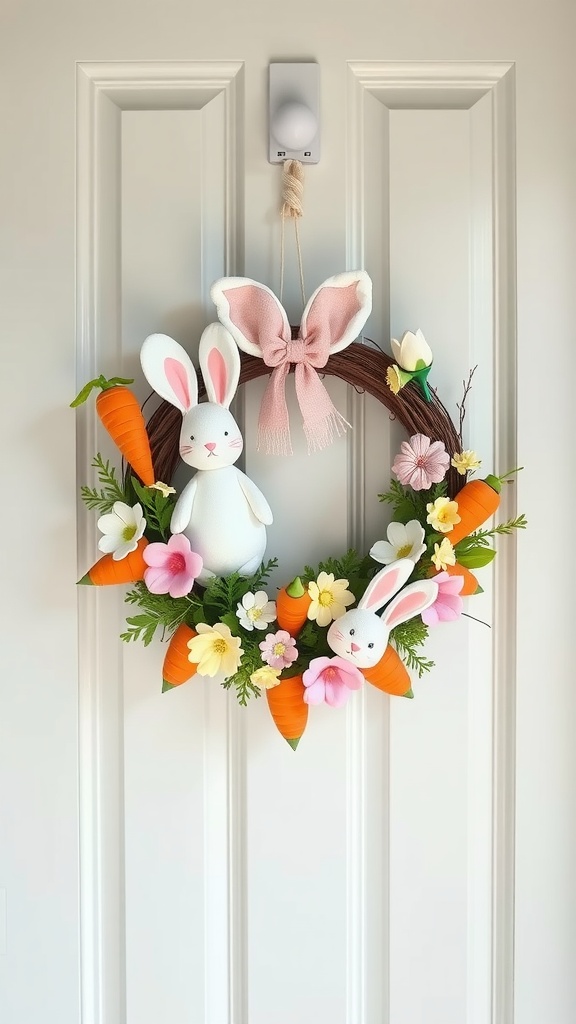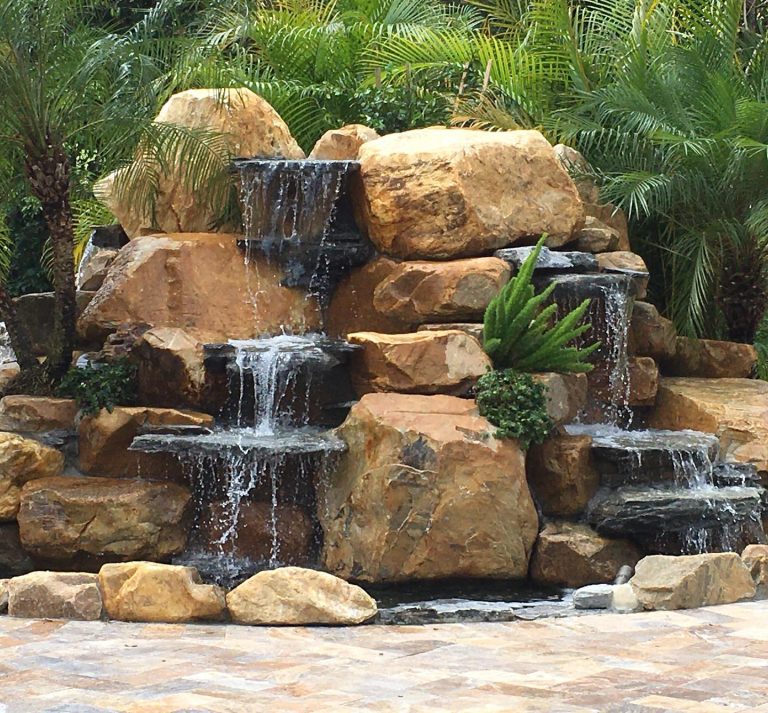17 Creative Rain Gutter Drainage Ideas for Your Home
Rain gutters play a crucial role in managing water drainage, but they can also be a stylish and functional aspect of your home. Here are 17 creative ideas to enhance your rain gutter system, from DIY solutions to trendy designs that not only keep your property safe from water damage but look great while doing it!
Downspout Splash Blocks
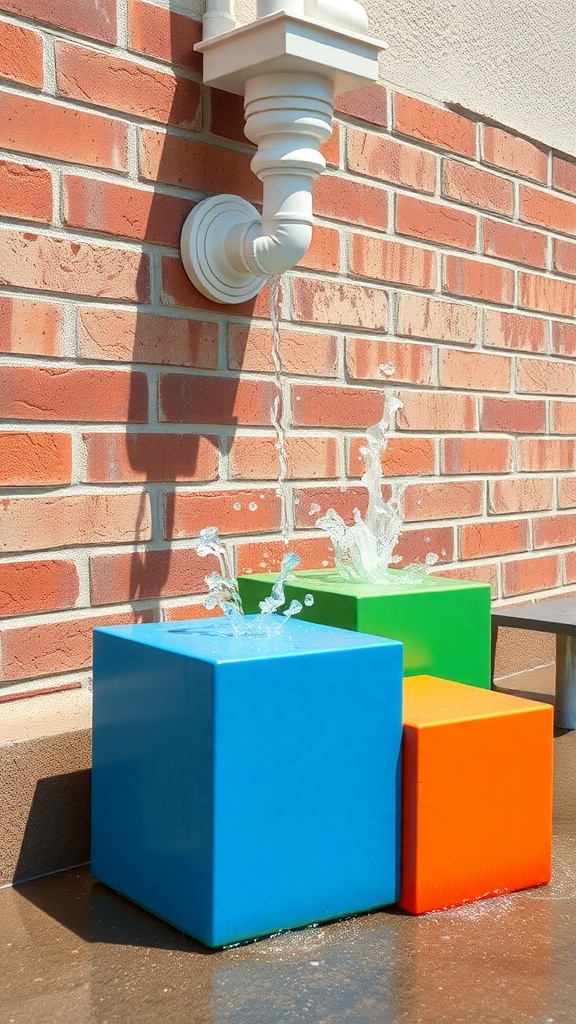
Downspout splash blocks are a fun and practical way to manage rainwater. They help direct water away from your home’s foundation, preventing potential damage. The image shows colorful splash blocks that not only serve a purpose but also add a splash of color to your yard.
These blocks catch the water coming from the downspout and disperse it evenly. This prevents erosion and keeps your landscaping intact. The vibrant colors in the image make them visually appealing, turning a functional item into a decorative feature.
When choosing splash blocks, consider materials that can withstand the elements. Plastic and concrete are popular options. You can even get creative with shapes and colors to match your outdoor decor. Splash blocks can be a simple yet effective solution for managing rainwater runoff.
Rain Barrel Setup
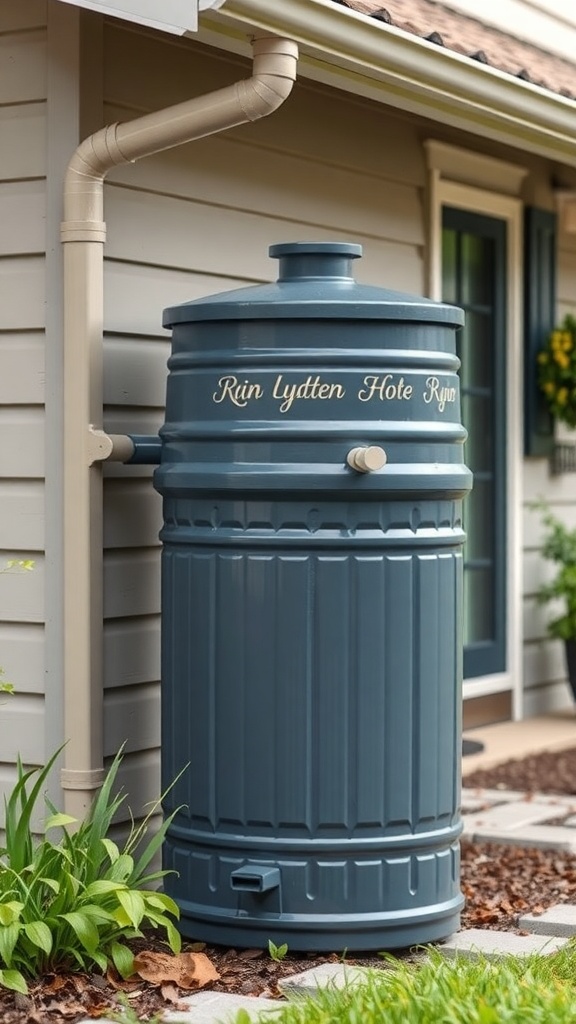
Setting up a rain barrel is a smart way to manage rainwater and support your garden. The image shows a stylish rain barrel placed next to a house, ready to collect water from the roof. This setup is not only practical but also adds a nice touch to your outdoor space.
The rain barrel connects to the downspout, allowing rainwater to flow directly into it. This helps reduce runoff and provides a free water source for your plants. You can use the spigot at the bottom to easily access the water when needed.
Choosing a rain barrel that fits your style is key. The one in the image is a lovely blue color, which can complement various home designs. Make sure to place it in a spot that gets enough rainfall and is easily accessible for watering your garden.
Dry Well Construction
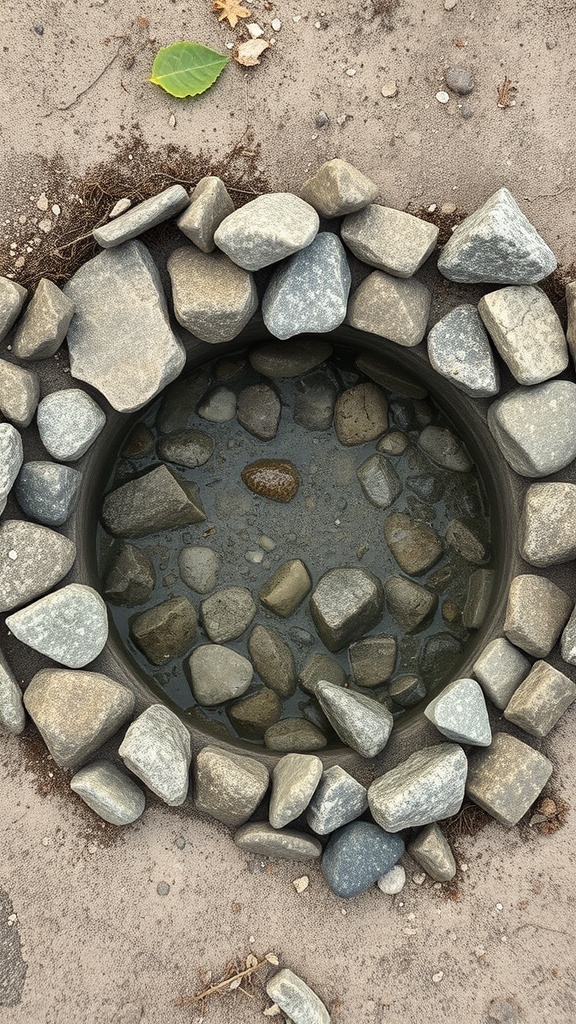
Creating a dry well is a smart way to manage rainwater drainage. The image shows a well that is partially filled with stones and water, designed to collect excess water from your gutters. This setup helps prevent flooding and keeps your yard looking great.
The dry well is surrounded by a circle of stones, which not only looks nice but also helps filter the water as it seeps into the ground. This natural drainage system can be a simple DIY project for homeowners looking to improve their landscape.
To build your own dry well, start by digging a hole in your yard. The size will depend on how much water you expect to collect. Line the hole with landscaping fabric to prevent soil from washing in. Then, fill it with gravel or stones, leaving space for water to flow through. Finally, cover the top with more stones for a neat finish.
Gutter Extensions
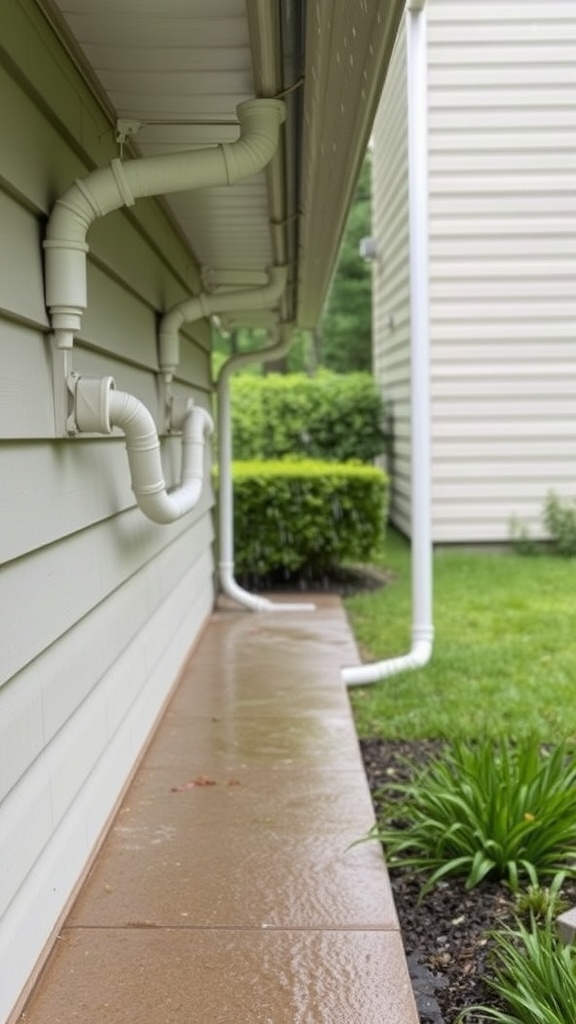
Gutter extensions are a simple yet effective way to manage rainwater drainage. They help direct water away from your home’s foundation, preventing potential damage. In the image, you can see a series of white gutter extensions running along the side of a house. These extensions guide water safely to the ground, away from the structure.
Using gutter extensions can also help keep your yard looking neat. By channeling water to specific areas, you can avoid muddy patches and erosion. The extensions shown in the image are well-placed, ensuring that rainwater flows smoothly and efficiently.
When considering gutter extensions, think about the layout of your yard. You want to ensure that water is directed to areas where it can drain properly. This might mean leading it to a garden bed or a designated drainage area. With the right setup, you can protect your home while enhancing your landscape.
Swale Design
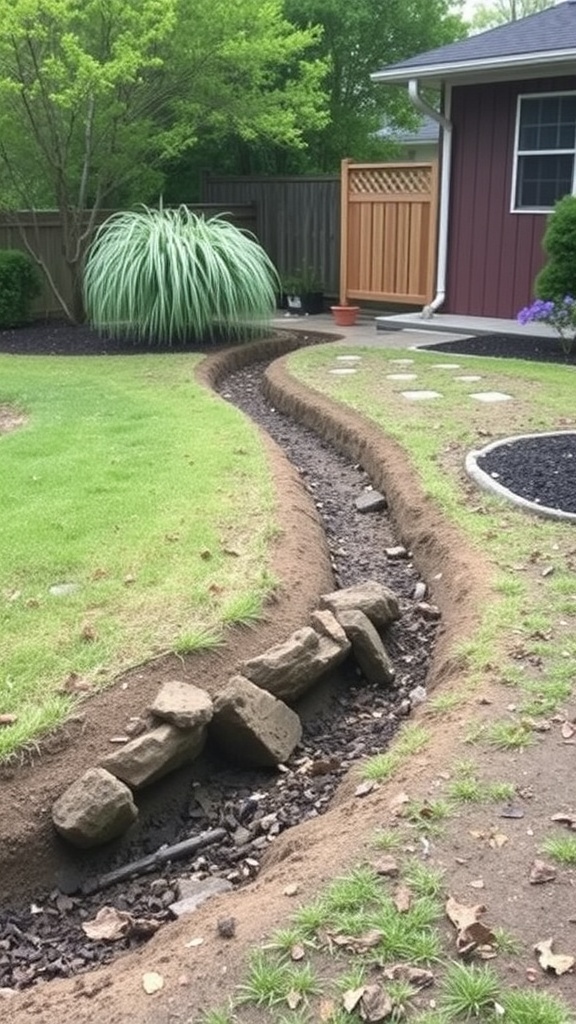
Swales are a fantastic way to manage water drainage in your yard. They are shallow, grassy channels that help direct rainwater away from your home and into the ground. The image shows a beautifully designed swale that curves through a garden area, creating both a functional and aesthetic feature.
The swale in the picture is lined with stones, which not only helps with drainage but also adds a natural look to the landscape. This design can prevent water from pooling, reducing the risk of flooding and erosion. Plus, it can enhance the beauty of your outdoor space.
Incorporating plants along the swale can further improve its effectiveness. Native plants are great choices since they thrive in local conditions and support local wildlife. This makes your garden not just practical but also a vibrant habitat.
Overall, a well-designed swale can be a stylish solution to drainage issues. It’s a simple way to keep your yard looking great while managing water runoff effectively.
Rain Garden Installation
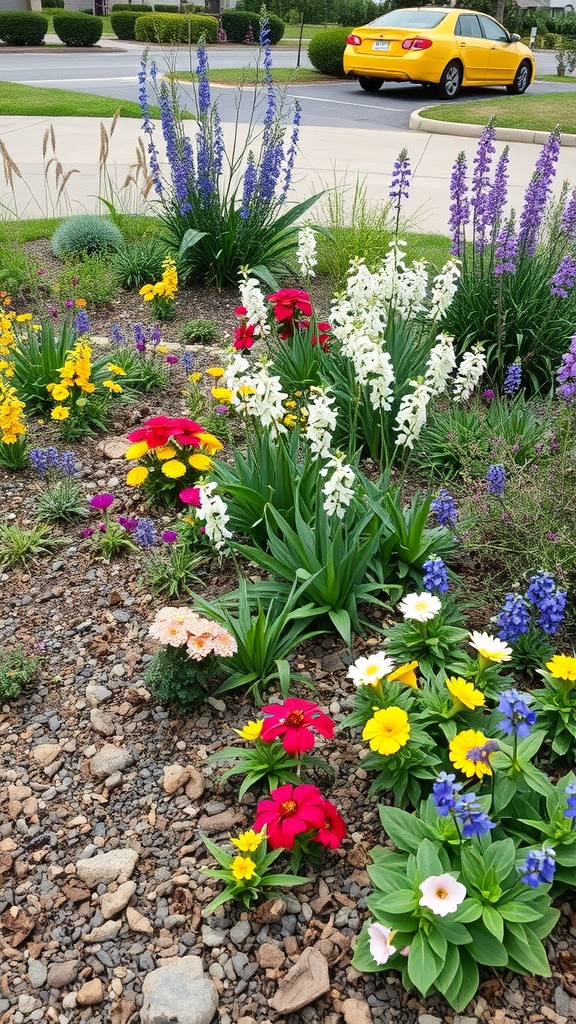
Creating a rain garden is a fantastic way to manage stormwater while adding beauty to your yard. The image shows a vibrant garden filled with colorful flowers and plants, designed to absorb rainwater runoff. This setup not only enhances your landscape but also helps filter pollutants from the water before it reaches local waterways.
When planning your rain garden, consider the types of plants that thrive in wet conditions. Native plants are often the best choice as they are adapted to the local climate and soil. In the image, you can see a mix of flowers, which not only look great but also attract beneficial insects.
To install a rain garden, start by choosing a location that collects water runoff, such as near downspouts or driveways. Dig a shallow depression and fill it with a mix of soil and compost to promote drainage. Then, plant your chosen flowers and shrubs, arranging them in a way that creates visual interest. The colorful blooms in the image show how a well-planned rain garden can be both functional and aesthetically pleasing.
Permeable Pavers
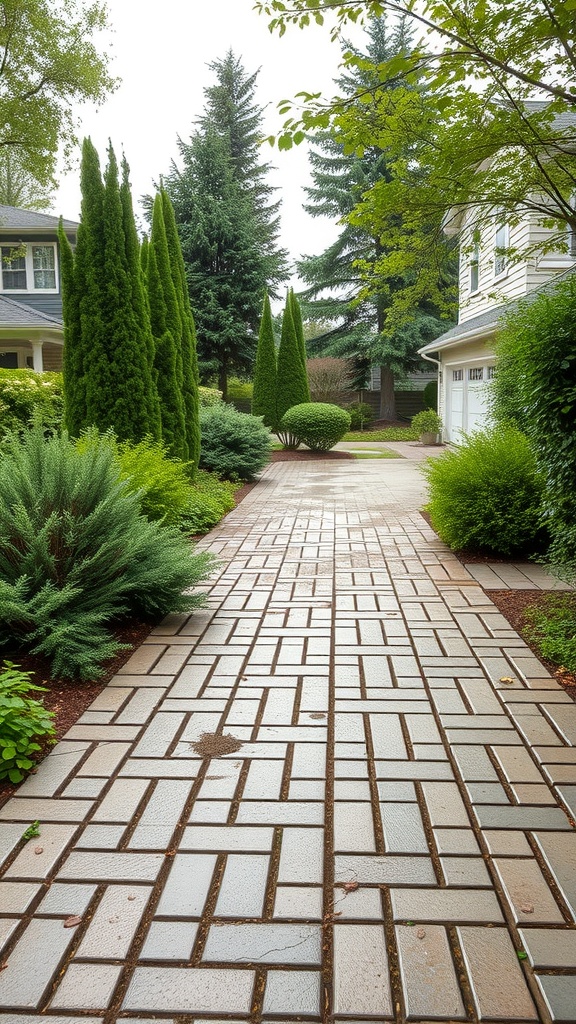
Permeable pavers are a fantastic way to manage rainwater effectively. They allow water to seep through the surface, reducing runoff and promoting drainage. This is especially useful in areas where heavy rainfall can lead to flooding or erosion.
The image shows a beautiful pathway made of permeable pavers. The design is not only functional but also adds a stylish touch to any landscape. The pavers create a neat, organized look while blending seamlessly with the surrounding greenery.
Using permeable pavers can help keep your yard healthy by allowing rainwater to reach the soil. This promotes better drainage and helps maintain the natural water cycle. Plus, they can be customized in various patterns and colors to fit your aesthetic.
Incorporating permeable pavers into your drainage plan is a smart choice. They enhance the beauty of your outdoor space while providing practical benefits. So, if you’re looking for a way to improve your rain gutter drainage, consider adding these pavers to your landscape!
French Drain System
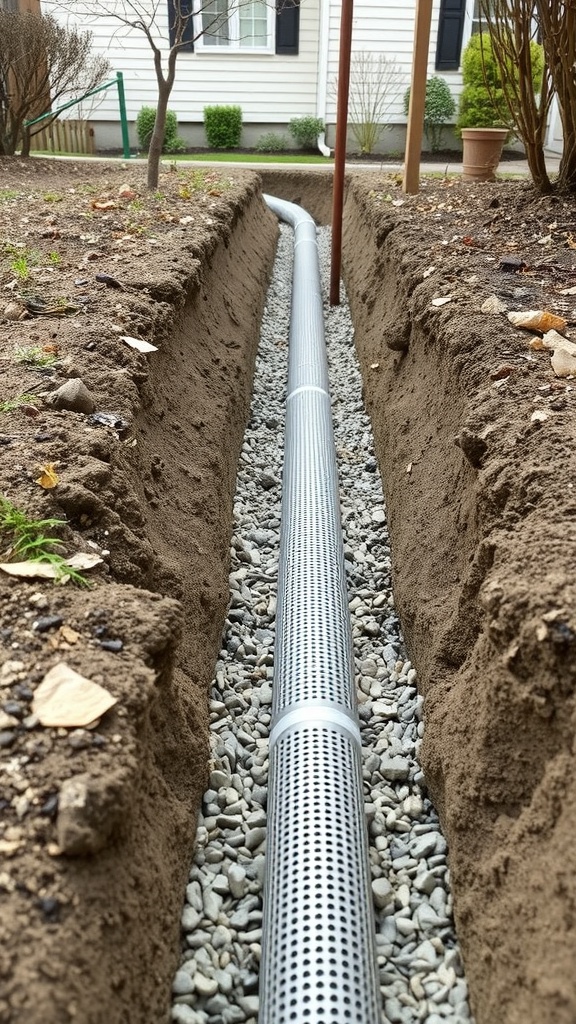
A French drain system is a smart way to manage water drainage in your yard. The image shows a trench filled with gravel and a perforated pipe running through it. This setup helps direct water away from areas where it can cause problems, like your foundation or garden beds.
The gravel allows water to flow freely into the pipe, which then carries it away from your home. This method is especially useful in areas that experience heavy rainfall or have poor drainage. By installing a French drain, you can prevent water pooling and protect your landscaping.
Setting up a French drain involves digging a trench, laying down gravel, and placing the pipe inside. It’s a straightforward project that can save you from bigger issues down the road. Plus, it blends well with your yard, making it a practical choice for drainage.
Bioswale Creation
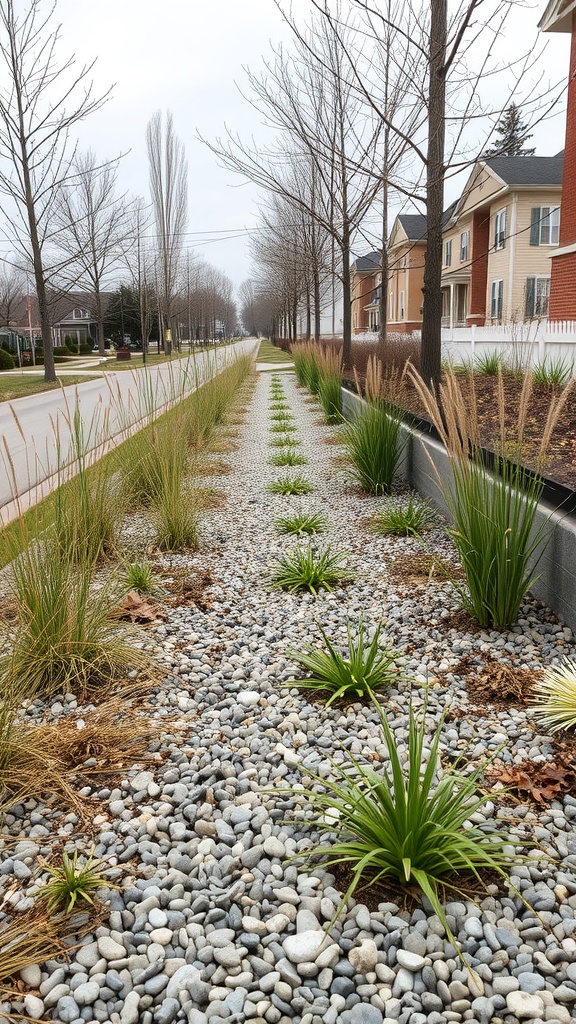
Bioswales are a fantastic way to manage rainwater runoff while adding beauty to your landscape. The image shows a well-designed bioswale lined with various plants and stones. This setup not only helps with drainage but also enhances the curb appeal of the area.
The plants in the bioswale play a key role in filtering pollutants from the water. They absorb excess nutrients and help prevent flooding. The gravel provides a natural drainage system, allowing water to flow through while keeping the area tidy.
Creating a bioswale can be a fun DIY project. Start by selecting a suitable location that collects runoff. Dig a shallow trench and line it with gravel. Then, choose native plants that thrive in your climate. This will ensure your bioswale is both effective and low-maintenance.
Incorporating a bioswale into your drainage plan is a smart choice. It’s eco-friendly and can turn a simple drainage solution into a beautiful landscape feature.
Rainwater Harvesting System
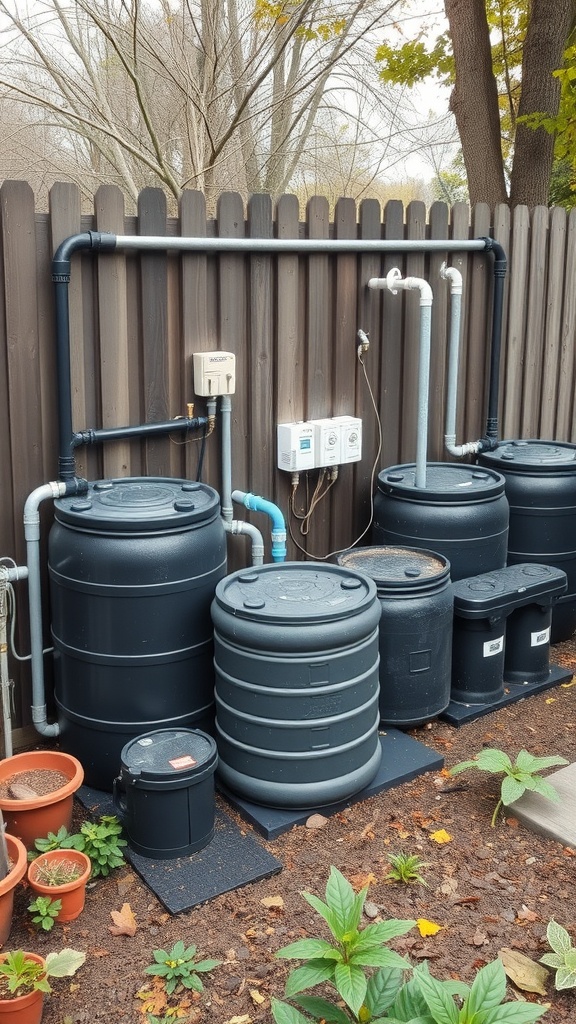
Rainwater harvesting is a smart way to collect and store rainwater for future use. The image shows a well-organized setup with multiple barrels connected by pipes. This system captures rainwater from the roof and channels it into storage tanks.
The black barrels are designed to hold a significant amount of water, making them perfect for gardening or other outdoor needs. The setup includes a filtration system to keep the water clean and safe for use.
Using a rainwater harvesting system can help reduce water bills and promote sustainability. It’s a great way to make the most of natural resources while keeping your garden thriving.
Soakaway Pit Installation
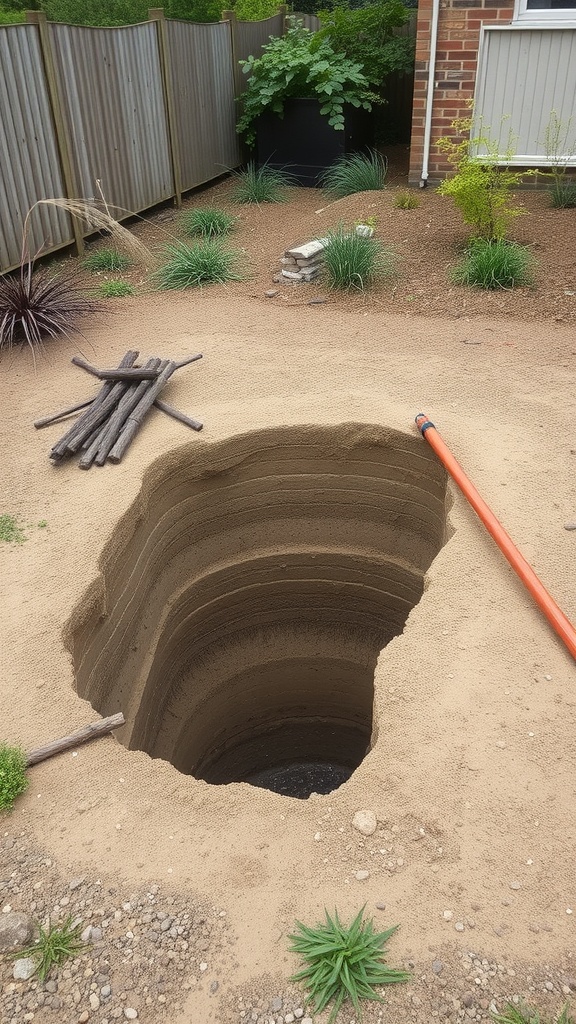
Installing a soakaway pit is a smart way to manage rainwater drainage. The image shows a freshly dug soakaway pit, ready for use. This pit collects excess rainwater from your gutters and allows it to slowly seep into the ground, reducing the risk of flooding.
The pit is deep and wide, designed to hold a significant amount of water. Notice the clean edges and the sandy base, which helps with drainage. Surrounding the pit, you can see some landscaping elements, like plants and stones, which can enhance the area’s appearance.
To install a soakaway pit, start by choosing a suitable location away from your home’s foundation. Dig a hole that’s at least 1 meter deep and 1 meter wide. You can line the pit with gravel to improve drainage. Once it’s ready, connect your downspouts to the pit using drainage pipes. This setup will help manage water runoff effectively.
Vegetated Roof Drainage
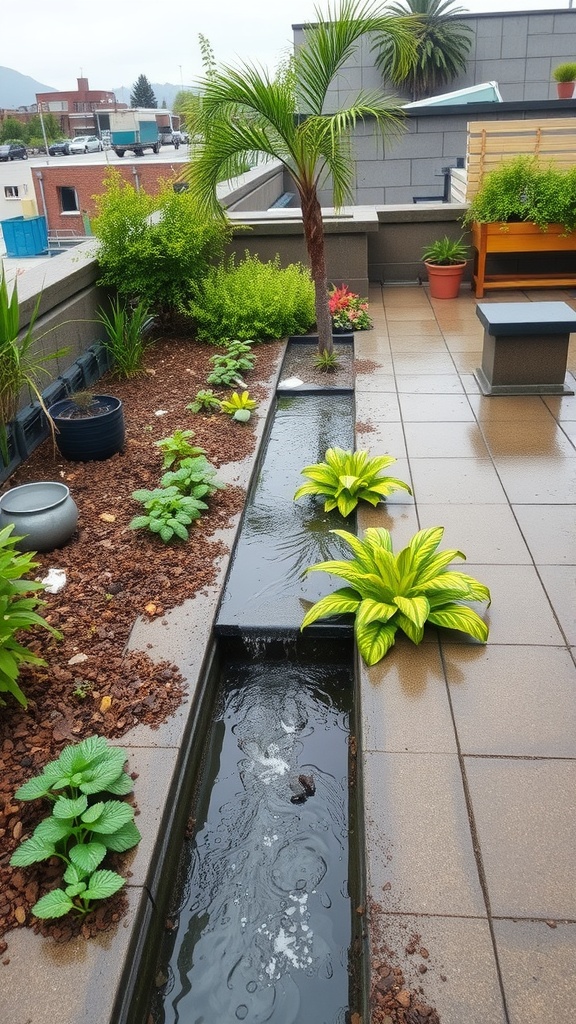
Vegetated roofs are a fantastic way to manage drainage while adding beauty to your space. The image shows a well-designed vegetated roof with a drainage system that channels water effectively. The plants not only look great but also help absorb rainwater, reducing runoff.
In this setup, you can see a mix of vibrant greenery and a water feature that collects rainwater. The plants are strategically placed to create a lush environment, while the drainage channel ensures that excess water flows smoothly away. This design minimizes the risk of water pooling and helps maintain the health of the plants.
Using a vegetated roof for drainage is eco-friendly and can improve insulation. It’s a win-win for both aesthetics and functionality. If you’re considering this option, think about the types of plants that thrive in your climate and how they can complement your roof’s design.
Rainwater Drainage Channel
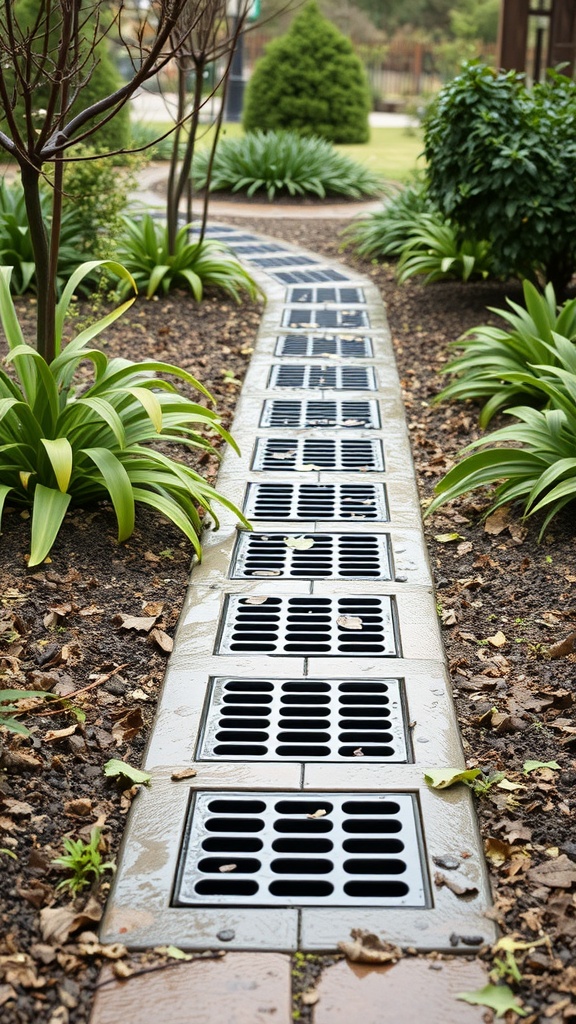
Rainwater drainage channels are a smart way to manage excess water in your yard. They help direct rainwater away from your home and prevent flooding. The image shows a well-designed drainage channel that blends nicely with the surrounding landscape.
The channel features a series of grates that allow water to flow through while keeping debris out. This design not only serves a practical purpose but also adds a neat look to your outdoor space. The use of plants around the channel softens the overall appearance, making it a functional yet attractive addition.
Installing a rainwater drainage channel can be a DIY project. You can choose materials that match your home’s style. Consider the slope of your yard to ensure proper water flow. This solution is effective in keeping your garden healthy and your home safe from water damage.
Gutter Guard Solutions
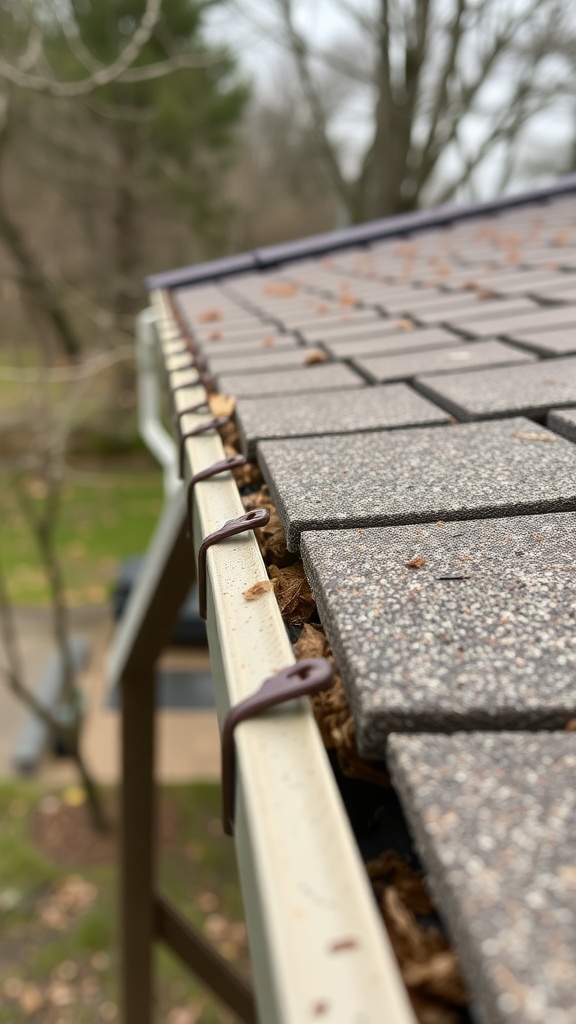
Gutter guards are a smart way to keep your gutters clean and functioning well. The image shows a close-up of a gutter system with a guard in place, highlighting how it catches leaves and debris. This setup helps prevent clogs, which can lead to water damage.
When choosing a gutter guard, consider the material and design. Some guards are mesh, while others are solid. Each type has its pros and cons. Mesh guards are great for filtering out small debris, while solid guards can handle larger items.
Installing gutter guards can save you time and effort in maintenance. With less debris buildup, you won’t have to climb up to clean your gutters as often. This means more time enjoying your home and less time worrying about water issues.
In the long run, gutter guards can protect your home’s foundation and landscaping. They help direct water flow away from your home, reducing the risk of erosion and flooding. So, if you’re looking for a simple solution to gutter problems, consider adding a guard to your system!
Green Roof Benefits
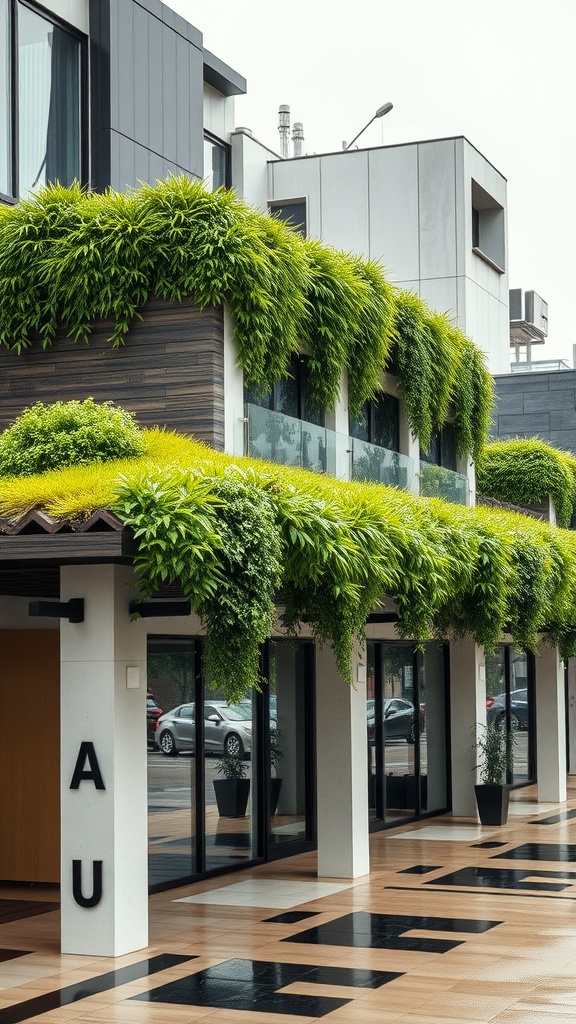
Green roofs are a fantastic way to enhance both the look and function of a building. The image shows a modern structure with lush greenery cascading over the edges. This not only adds beauty but also offers several benefits.
One major advantage of green roofs is their ability to manage rainwater effectively. The plants absorb rainwater, reducing runoff and helping to prevent flooding. This is especially important in urban areas where drainage systems can be overwhelmed.
Another benefit is insulation. The vegetation acts as a natural insulator, keeping buildings cooler in the summer and warmer in the winter. This can lead to lower energy costs and a more comfortable living environment.
Moreover, green roofs improve air quality. Plants filter pollutants and carbon dioxide, releasing oxygen back into the atmosphere. This contributes to a healthier environment for everyone.
Lastly, they provide a habitat for wildlife. Birds and insects can thrive in these green spaces, promoting biodiversity in urban settings. Overall, incorporating green roofs is a smart choice for both aesthetics and sustainability.

